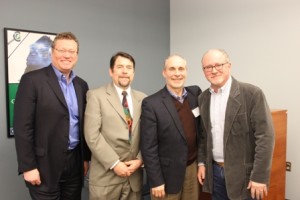The Chester County Economic Development Council’s Smart Energy Initiative recently held its annual Energy Briefing on February 24th. Special thanks to our event sponsors: Silicon Power, PECO Smart Ideas, Community Energy, Practical Energy Solutions, and Brandywine Valley Heating and Air Conditioning.
Below, please find the key messages and insights shared by our panel of specialists in the energy industry and energy policy: Pictured from left: Steve Krug of Krug Architects and SEI Programming Committee Chair, Rob Graff of Delaware Valley Regional Planning Commission; Steve Mullin, President Econsult Solutions, Inc. and Mark Alan Hughes, Faculty Director at the Kleinman Center for Energy Policy at the University of Pennsylvania.

- What energy trends are of greatest relevance to energy professionals in southeastern Pennsylvania?
- Energy Efficiency and Natural Gas Technologies, such as Combined Heat and Power (CHP), in the region.
- If working in other states, alternative energy sources are supported in NY, NJ, DE and MD.
- Electric car charging stations in urban areas.
- ESCO (Energy Service Companies) and GESA (Guaranteed Energy Savings Act) opportunities.
- How might the US EPA’s Clean Power Plan affect our region?
- “It’s a jujitsu between policy taking and policy making” Leadership cannot reconcile this debate. Until we know what our plan is related to achieving goals, we cannot say to what degree we can reduce carbon/green house gas emissions.
- Local/regional challenge on energy policy is balancing policy-making vs policy-taking. Cities especially have a charge-of-the-light-brigade impulse on progressive energy/climate goals, and they joyfully accept the implementation lead on OPG’s (other people’s goals) like COP21 (World Climate Summit/Paris Climate Conference).
- But even on most local jurisdictions, they ultimately are policy-takers (e.g., building codes). Sure, lots of discretion in Am federalism, and best policy-maker opportunities are on the many forms of energy waste.
- Many cities including Philadelphia have done feasibility studies on meeting the goal of 80% reduction in carbon/greenhouse gas emissions. How many mayors have you heard say it’s their goal to be the greenest city in America? Ultimately, the better local/regional question is not about feasibility but about optimality. Not about “can we” but rather needs to be about “should we” direct limited municipal resources and time toward achieving these goals, which are largely reliant on activities out of municipal control?
- Mitigation is out of date; adaptation is the real key to success.
- The Clean Power Plan statement of “reduce green house gas emissions by 32%” is not a goal, it’s a projection. It’s about reducing air pollution without unduly burdening industry. The EPA allows regions to do what they want to meet goals.
- What challenges and opportunities are presented by the Marcellus and Utica shale resources?
- Surveyors, Civil Engineers, Earthwork Contractors, Pipe Fitters and Tree Removal Services have been involved in the Gas Pipeline distribution.
- Right of Way (ROW) permitting has been a challenge.
- Senator Dinniman and Senator Rafferty have proposed legislation to register land brokers, in the same way realtors are registered with the state, to help improve ROW communication.
- Energy shopping and negotiations for large energy users are opportunities, because prices have dropped.
- Can the Energy Hub vision and the Renewables Revolution co-exist? YES
- Energy waste can be a huge contribution toward meeting the Clean Power Plan’s goal of reducing green house gas emissions by 32%. Albeit, the energy efficiency building block was removed from the Clean Power Plan, energy waste and energy efficiency remain a huge contribution to meeting the goal. And yet, fossil fuel costs are dropping which makes alternatives more challenging. And fossil fuels will likely continue to remain low cost.
- The 1st best solution is a revenue neutral cost on carbon emissions, but that’s unlikely to be successful, so we need to look at the 2nd best solutions that are more practical and are able to be implemented and controlled regionally. One of those is to create club like mechanisms to achieve real changes.
- Is there a way to have clean energy that’s also affordable? Is the infrastructure set up for people to really take advantage of incentives? Finding passion for alternatives is challenging as cost of gas and oil reduces. It’s really a long term story about efficiency of renewables. Much like the challenge of not making food prices higher.
- Call to action: Businesses must and will find a way to drive costs down and reinvest their savings in energy today toward renewable energy options for the future.
- Can public support for clean energy and the public demand for inexpensive energy both be met? YES
- Are we too late? No. There is still time to make it better, or at least “less worse”
- Best story is always when supply = demand. But we need to explore 2nd best theories. One idea shared was that there needs to be more push for taxes on things like gas to support clean energy options.
- The adaptation challenge has to be addressed and we need public support for it. Just think of it . . . with the statistically proven impact on climate change, Canada will have the same climate as PA in 30-40 years if we don’t start changing.
- Best historical experience is back in the 1980’s with France with their nuclear energy introduction; they achieved 5% per year reduction in carbon emission! Perhaps if we put it in the language of local health impacts vs. gas emissions or monetary impacts we can get more public support.